Woodies 2016

|
There are new collections of several species of Acer being added this season. So this is your opportunity to obtain smaller plants while they last, of A. erythranthum FMWJ13157
|
 |
A. laevigatum FMWJ13439
|
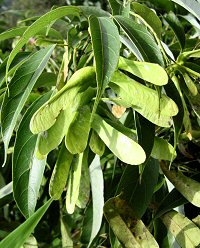 |
and two collections of A. laurinum FMWJ13412 & KWJ12232 all from northern Vietnam. The last species being a re-identification from A. oblongum, shame there are no labels on the trees we collect from.
|
 | There is also a recent collection of A. japonicum CWJ12840 from the cold high mountains of Shikoku Island,
|
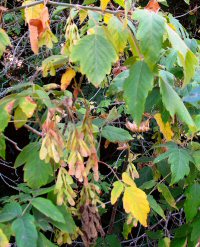
|
as well as a new species for us A. negundo BSWJ14060 from The Russian River, California from our 2014 trip.
|
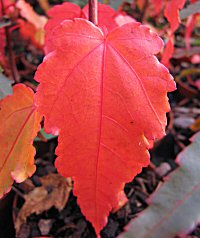 |
While there is also a new collection of A. sikkimense FMWJ13166 from northern Vietnam,
|

|
we are also able to offer a remarkably different form that is more conventionally deciduous as A. sikkimense from the Himalayas WJC13674.
|
 |
It was John Hillier that commented on Betula insignis ssp. fansipanensis FMWJ13149 when he visited our growing fields last spring, that it has the best foliage of any species. Which is hardly surprising when you become acquainted with this Vietnamese subspecies, as they are bronzy from spring through to autumn on a handsome leaf to-boot.
|
 |
We used to offer Bupleurum fruticosum some time ago, but for some reason we could no longer get our seed to ripen, well that has been rectified.
|
 |
We had great difficulty in identifying Cestrum buxifolium BSWJ14395 firstly on account that there is not a Flora covering Colombia. The genus was no problem at all, but our identification kept on going back to this species, but always with yellow flowers, until that is I finally tracked down a pressed specimen with bicoloured flowers as is the case in this collection. An exceptionally attractive high altitude small shrub in the wild with the characteristic tubular flowers held in profusion from the leaf axils close to the ends of the branches.
|
 |
Escallonia myrtilloides BSWJ14329 may not have been from a lofty 4,000m as the previous, but 3,300m is quite good going, where it formed wide shrubs with the most intriguing of top-shaped flowers.
|
 |
We offered a collections of Clethra fabri FMWJ13037 for the first time last season, just as well we waited until we had a back up stock of this exquisite species with bright red young growth, as it sold out very quickly considering how large they were.
|
 |
Also from the north of Vietnam and collected from within spitting distance of the previous, is Dendropanax cf. kwangsiensis FMWJ13274. As supply is limited I am tempted not to say too much as the demand for this genus is high, it would appear every Botanic Garden in Europe would like one.
|
 |
I suppose the same applies to Exbucklandia tonkinensis KWJ12209, but these will be for collection only as they have already reached a fair size, while as yet nobody can propagate them from cuttings.
|
 | Still in this same area of Vietnam, we were puzzled by our encounter of Fagraea ceilanica FMWJ13099. A beautiful medium sized tree peppered with yellow aubergine-like fruit with small seed scattered therein. Gentian family of course!
|

|
Ilex chapaensis HWJ946 again from Vietnam, has been here for a while as we originally collected the seed back in 2003, not even being sure that it was a holly until it flowered. Some of our plants have endured the worse of the weather during the cold winter of 2010/11 merely shrugging off –15C in a cold spot in one of our fields.
|
 |
Illicium merrillianum HWJ1015 faired well that winter too, but in a more sheltered garden situation. At long last we have plants to offer of this red flowering Vietnamese species, which flowers for us from the end of May.
|
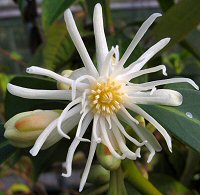 |
I. macranthum BSWJ11809 has been too scarce to risk our only stock plant, therefore has not had the same test, but we are confident of its hardiness. Looks to be close to I. simonsii to me, but larger flowers on longer peduncles. Destined to be popular.
|
 |
Our collection of I. anisatum BSWJ8411 has taken us far too long to build up stocks, but I feel that most will be well acquainted with this species we collected from Japan.
|
 |
There will be additional Vietnamese Magnolia collections added, including a collection of M. foveolata and some M. floribunda, which includes a form FMWJ13384 with exceptionally hairy stems from the slopes of Fansipan, that we are applying the cultivar name of ’Fansipan Furry’ under the appropriate heading in this year's introductions.
|
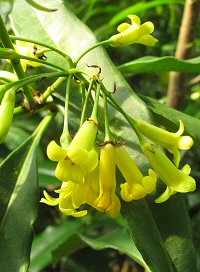 |
From a bit further north bordering Yunnan Province we found the distinct seed capsules of Pittosporum glabratum v. neriifolium BSWJ11685. This variety is a great addition, yet another evergreen shrub with linear evergreen leaves that always fit into the garden so well, contrasting with so many elliptic leaves.
|
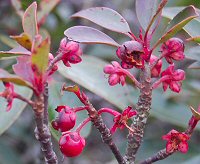 |
Ternstroemia are not well known in cultivation in the UK, I have the distinct feeling that T. kwangtungensis FMWJ13402 will speed up this transition period. As this was an attractive and tidy small shrub where we found it growing on an exposed ridge almost in China on the Vietnamese border.
|
 |
Finally from this area are a couple of additional collections of Rhodoleia in the form of FMWJ13155 & FMWJ13422, just hope we can find more room in the garden for yet two more collections of these showy members of the Hamamelis family.
|

|
I had been on the lookout for Coriaria terminalis f. fructu-rubro for some time. Michael Wickenden was the one that finally came up with it from one of his collections KWL118 from their Upper Dulong River expedition to north-western Yunnan, China in 2008. A form with more orange fruit rather than a bright red.
|

|
Our collection of Daphne bholua from India GWJ9436 has been in our garden for quite some time. It flowers through the winter during milder winters or early spring in harder winters, with flowers every bit as good as named forms, or am I bias? These are all seed raised, we find that you have a better root system that way. We will also be offering a new collection of Daphniphyllum macropodum BSWJ12691, this time from South Korea collected while there in 2010.
|
 |
The keen eyed may spot Deutzia corymbosa on our list, this is again another re-identification from D. compacta. Our book did not mention that species for Sikkim. We will also be offering D. discolor ’Major’ as seen dotted about our gardens, thanks that is to Chris Sanders for giving us a positive identification on this old cultivar.
|

|
Speaking of old, we have a collection joining our list of Deutzia pulchra from the Philippines BSWJ3948 which we collected in 1996. Diospyros species from Vietnam FMWJ13164 was initially identified as D. lotus, but I am disagreeing with that, hence it will take a bit more time for me to look into it. The foliage is softly pubescent while the fruits were small with a large calyx.
|
 |
From the same mountain Euonymus frigidus KWJ12275 displays purple four-merus flowers in vast quantities, set off by pale green crenate foliage.
|
 |
The foliage of E. porphyreus BSWJ13914 is unmistakable, narrow and willowy is how we found it in West Bengal in 2013 in pockets of remnant forest on the Singalila Ridge. Lindera neesiana BSWJ13984 was a collection gathered on our descent form small trees full of flower buds ready for the spring display. As was Magnolia doltsopa BSWJ13996 with upright spikes of fruit, with oblong-lanceolate leaves growing in the shelter of the valley.
|
 |
One of our primary target plants from our Himalayan expeditions of 2013, was Merrilliopanax alpinus BSWJ13939, which we had collected on previous occasions, but only resulting in only a few plants (remember our RHS Chelsea displays). A determined effort has produced enough plants to offer, from three successful accessions. Although hardly known in cultivation, we are confident that this will change, when the paddle-like leaves of this deciduous long lived tree or large shrub is seen in gardens. Pittosporum napaulense is also from that neck of the woods albeit from a lower elevation, rather than a collection this was given to us, hence we have no first hand experience of growing this species. I am told it requires some shelter from low temperatures.
|
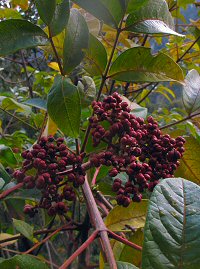 |
We were really pleased with ourselves for finding Tetradium fraxinifolium WJC13750 in the eastern Himalayas. We had seen some of the fruit offered for sale in some of the local markets there, without identifying it while separated from its distinct pinnate foliage. Quite different from what was identified for us in Vietnam, I can see another re-identification on the horizon.
|
 |
Finding Tetracentron sinense v. himalense WJC13818 was not only memorable, but one of the highlights of our Himalayan expedition. I’ll never forget looking up into the trees through my binoculars and seeing the distinct catkin-like spikes and blurting out its name, as I had no idea there was a Himalayan form of it. Needless to say our guides have been pointing it out to all and sundry ever since, as one of the rarest trees.
|
 |
Moving on to the Far East we are adding our most recent collection, of the long awaited re-identified endemic Sorbus from the remote South Korean island of Ullüngdõ. S. ullungdoensis BSWJ12640 is a very distinct chunky species long incorporated in S. commixta, always distinct in its fiery autumn foliage.
|
 |
While from the north of Japan we have Gamblea innovans which can be seen for miles in the autumn due to its bright yellow trifoliate leaves, easily associated with the ginseng family when seen in fruit as is Merrilliopanax, but again virtually unknown in British horticulture. We aim to educate.
|
 |
A contrasting evergreen are Neolitsea sericea BSWJ12738, which we found both in Korea and Japan. The emerging foliage can set the heart alight of even the most conservative of growers, not to mention the display of red fruit. Even more tempting is a yellow fruiting collection from southern Japan, N. sericea with yellow fruit CWJ12830.
|

|
From China comes Meliosma myriantha v. discolor MF97132 a much admired shrub in our garden, on account of its handsome herring-bone foliage adorned with panicles of small creamy-white flowers in the summer. A gratefully received gift from Maurice Foster.
|
 | Moving south to our oldest happy hunting ground of Taiwan, we are adding another collection of the elegant Schefflera taiwaniana AGM BSWJ3788. Keeping true to our original introduction, this form is of the smaller more shrubby well branching style, from the Central Mountains.
|
 |
Turpinia ternata CWJ12360 also hails from this magical isle, is an evergreen from the Staphylea family, which hit the headlines for the wrong reason, when someone broke into the nursery to steal one.
|
 |
Sarcococca taiwaniana RWJ9999 a star feature in the television program that followed us for a year, accompanying us to Taiwan in 2003. Which was when we gathered our original collection of this unidentified species, then having to ceremoniously burn our one and only plant on camera, to funeral music. Luckily we had gathered a bit of seed, but plan B had also kicked into play. Our co-collectors, The Taiwan National Museum of Natural Science, had also collected plants and had de-bugged them. Presenting us with a replacement plant from the same collection on our return there in 2007. It has yet to be officially named as the above. So what I want to know is, who is going to be the first person to complain about the price?
|
 |
Mahonia oiwakensis from Hong Kong PBR371 was another gratefully received gift from Holland. So far it looks different enough from our Taiwanese collections to be distinguished. No sign of it in the areas of Hong Kong we were in this last autumn.
|
 |
Frangula californica BSWJ14057 was collected as a Rhamnus, from a hidden valley under the name of The Cedars, just an hour’s drive from San Francisco, California at 1,300 feet. Where there were only a small amount of its black fruit left.
|
 |
Which brings me to our final introduction for this season from much closer to home, Ruscus × microglossum BSWJ14041 Will be a new name to many, but we have seen the plants in cultivation here in the UK under the species name of one of its parents. It is thought to be a natural female hybrid between the eastern Mediterranean species of R. hypoglossum and the western Mediterranean species R. hypophyllum. Traditionally grown in countries such as Italy in those gaps that appear at ground level under evergreen hedges or surrounding specimen shrubs that are surrounded by lawns.
|